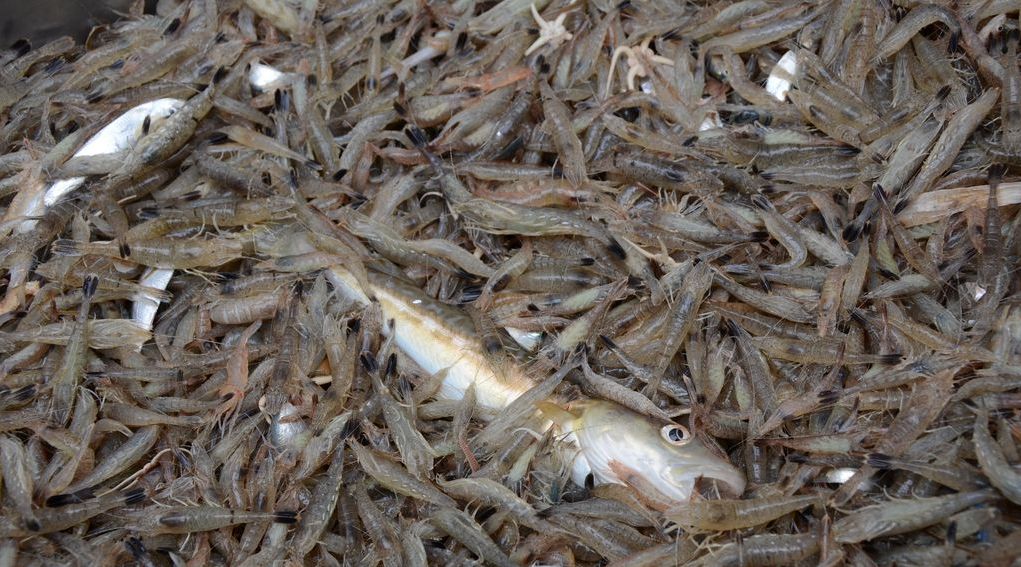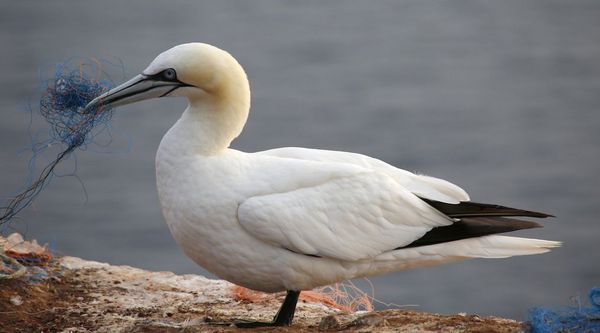Shrimp fishing is currently the most valuable German coastal fishery. As it fishes with small-meshed nets at the seabed partly in ecologically sensitive areas, we are working on improving fishing methods.
The target species of shrimp fishing in the North Sea is the North Sea shrimp Crangon crangon. These animals, a few centimetres in size, live in the North Sea and other seas, mostly on the seabed. Nowadays, so-called beam trawls are generally used to catch shrimp. These are bottom trawls that are pulled directly over the seabed. The roller bottom trawl scares the shrimps up from the seabed so that they can be caught in the net. As the shrimps are relatively small, the meshes in the net must also be relatively small. From 2024, a new minimum mesh size of 22mm will apply in the North Sea. However, the use of small meshes prevents larger animals of other species from escaping. For this reason, the use of sievenets or sorting grids is mandatory in fisheries. These selection devices allow many of the larger individuals of other species to escape underwater, although there is still room for improvement.
In addition to the bycatch of large and undersized individuals, other important research topics in this fishery are the high energy consumption - with the resulting high costs and CO2 emissions - and various impacts on the marine environment.
Accordingly, the Fisheries and Survey Technology working group at the Thünen Institute of Baltic Sea Fisheries is working on various topics, including several projects, to improve the sustainability of North Sea shrimp fishing.
Current hot topic
Bycatch reduction in shrimp fishing
The use of sievenets or sorting grids is mandatory in the North Sea shrimp fishing industry. These are intended to reduce unwanted bycatch in shrimp fishing. Large animals and objects in particular are directed out of the net, whereas smaller individuals (e.g. North Sea shrimp) can enter the codend through the meshes of the sievenet or the sorting grid and are caught. However, the sieve et is used almost exclusively in the fishery. When using the sievenet, it can happen that marine biota (algae, seagras and bryozoans or jellyfish), get caught in the netting and thus clog the sievenet. However, this can significantly impair the catch of shrimps.
The use of sorting grids would offer some advantages here. However, current sorting grids are still inadequate in terms of handling and results. For this reason, we are working on new concepts to avoid bycatch in shrimp fishing.
Schleswig-Holstein shrimp fishing innovation programme project (2020-2024)
Modifications to fishing gear can play a central role in the sustainable development of shrimp fishing. The shrimp fishermen themselves have a variety of ideas for this. However, implementation and trialling have so far been mostly slow, sporadic and anecdotal. The reasons for this were financial hurdles in the procurement of fishing gear and a lack of scientific support for the trials. Among other things, this meant that many good ideas were either not trialled or the results of the trials were usually not systematically recorded and shared in the fishery.
In 2019, the shrimp fishing advisory board of the state of Schleswig-Holstein therefore decided to support the shrimp fishing industry and utilise its wealth of experience, expertise and ideas. For this reason, the Schleswig-Holstein innovation programme "Making better use of shrimp fishery ideas" was launched. The Thünen Institute's fisheries and survey technology working group played a key role in designing the innovation programme and is providing scientific support for the trials.
More information are available soon.
Projekt DRopS (2018-2020)
Reducing plastic waste from shrimp fishery through net modifications
Due to the low design of the nets used in shrimp fishery for North Sea shrimp (Crangon crangon), the codends are very close to the bottom when being towed. In North Sea shrimp fishery, so-called „Dolly Ropes“ (polyethylene ropes) are often used as abrasion protection. The abrasion or loss of Dolly Ropes causes plastic particles to enter the sea and thus contribute to marine pollution. Abraded fibres from these Dolly Ropes are not only found in large quantities on beaches, but also pose a danger to seabirds and ship propellers.
As part of this project, net modifications were developed and tested that reduce or prevent contact between the net and the seabed, thus making the use of Dolly Ropes as abrasion protection superfluous.
DRopS project (2018-2020)
Reducing plastic waste from shrimp fishery through net modifications
Due to the low design of the nets used in shrimp fishery for North Sea shrimp (Crangon crangon), the codends are very close to the bottom when being towed. In North Sea shrimp fishery, so-called „Dolly Ropes“ (polyethylene ropes) are often used as abrasion protection. The abrasion or loss of Dolly Ropes causes plastic particles to enter the sea and thus contribute to marine pollution. Abraded fibres from these Dolly Ropes are not only found in large quantities on beaches, but also pose a danger to seabirds and ship propellers.
As part of this project, net modifications were developed and tested that reduce or prevent contact between the net and the seabed, thus making the use of Dolly Ropes as abrasion protection superfluous.
CRANNET project (2013-2015)
Optimising the codend in shrimp fisheries
In the CRANNET third-party funded project - together with colleagues from the Thünen Institute of Sea Fisheries and the University of Hamburg - the use of different codends (end bags of the trawl net) was trialled. In previous studies on the selection of shrimp nets, particular emphasis was placed on reducing bycatch. Nets that run the risk of losing marketable shrimp through the mesh were not taken into further consideration. However, this earlier approach ignores the fact that shrimp grow very quickly and that escaped shrimp gain enormous biomass within a very short time. These population effects are taken into account in the CRANNET-project with the help of a population model and used in the next step for economic optimisation. In the project, the Fisheries and Survey Technology working group was responsible for the investigations into the selection of the nets and the drag resistance.

![[Translate to English:] [Translate to English:]](/media/_processed_/d/7/csm_Startseite-OF_03_c0dfd6e750.png)
![[Translate to English:] [Translate to English:]](/media/_processed_/a/3/csm_20181116-151457-Stella-Jerome-Fischfalle-Warnem%C3%BCnde-Dorsche-im-Netzk%C3%A4fig-5691_heller_3050c72fa2.png)










